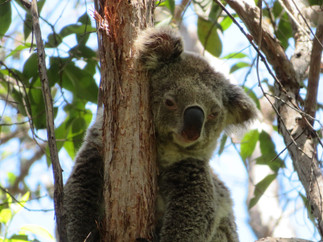Koala
- Ian
- Jan 18, 2022
- 3 min read
Updated: Feb 14, 2022
Koala (Phascolarctos cinereus) is an iconic Australian marsupial.
Unlike its closest living relative, the wombat, the koala is tree dwelling. It is most active at night, sleeping during the day, leading to the false belief that the animal is lazy, just hanging around during the day sleeping.
They are very dexterous, easily moving through the trees, jumping from branch to branch, clutching the branches with their strong and sharp claws. They tend to only come down from the trees when necessary.

They eat a range of leaves usually from eucalypts trees but not exclusively. Their favourite food tree at Istari is the red forest gum (Eucalyptus tereticornis) but this changes from location to location according to the availability of food trees. They have also been known to eat casuarinas and paperbark leaves as well although we haven't seen that here.

They carry their young, called joeys, in their pouch until about six to seven months when they get too big for it. After this they are often carried on their mother's back as they continue to provide milk until about twelve months old. In addition to the milk the mothers also produce a faecal pap from predigested leaves and feed this to the joey. This prepares the youngster for its adult diet of leaves.


Koalas were thought not drink water but take the water from the gum leaves they eat. However they will drink water when necessary. We have recorded them on the ground during the night and sighted them on the ground when moving to trees they can't manage jumping from branch to branch.
Our wildlife camera caught one on a wander down our bush path in the young forest.
Koalas are relatively solo creatures, spending most of their life alone. They do call to each other though, especially when males are looking for females. We hear koalas here regularly. They call at night when they are most active. The males bellow with a grunting sound that seems out of character for this extremely cute animal. The females will answer with a similar but quieter squeal.
Koalas are difficult to see. During the day they don't move around a lot and when wedged in a branch in a tree they become nothing more than a small blob, especially when far up a tree. They can be up found in any tree, not just koala food trees, which make finding them even harder. Although we hear them regularly we generally don't see any, despite constantly looking for them. They do tend to like specific trees so once you see them in a particular tree it isn't uncommon to see them there again. We had a single individual in or near a specific tree for six weeks.

If koalas are around you will find koala scats around the base of the tree they have been in. These are a little larger than a peanut. This is a common method to identify koala presence.

Koalas are under threat
Koalas are under considerable threat in much of Australia mainly from loss of habitat and encroaching human occupation. Human development clears their habit and brings cars and dogs into contact with them.
Fortunately they have continued to be successful on Istari but so much of their habitat is now lost. It is imperative we preserve and add to their habitat by planting koala food trees.
Ultimately without habitat all our wonderful fauna and flora won't survive without protection and preservation measures.
Koala Gallery
We will continue to update this blog and add to the gallery below. Enjoy.
See more of our photos in our koala gallery
Koala Links























Comments